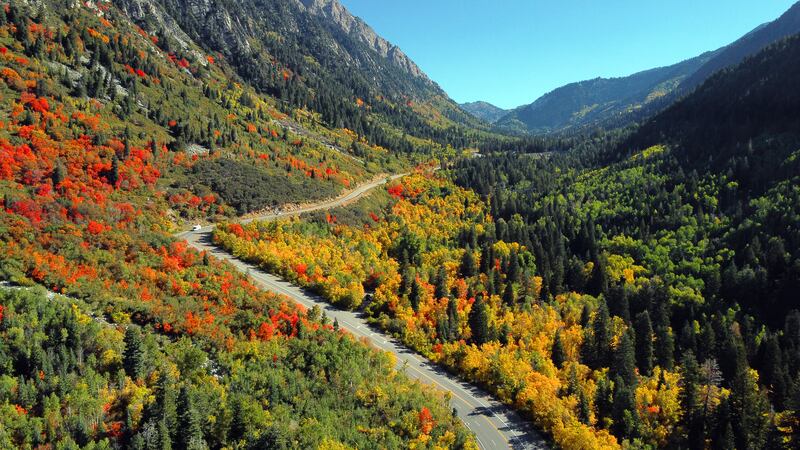Following a fiery public comment period, the Salt Lake County Council passed a resolution Tuesday opposing the recently recommended gondola for Little Cottonwood Canyon, while calling for “commonsense” transportation solutions.
The resolution, which argues the Utah Department of Transportation’s yearslong study “failed to adequately and effectively consider alternate transportation modes” in Little Cottonwood Canyon, articulates what a handful of Salt Lake County politicians have been saying for the last year — rather than spend over half a billion dollars on the longest gondola in the world, consider smaller, less invasive alternatives first.
After a lengthy debate, the resolution passed with a 5-4 vote, the “no” votes being Council members Dave Alvord, Aimee Winder Newton, Steve Debry and Dea Theodore.
Though the resolution has little sway over the project, some Council members on Tuesday said it sends a cautionary message to state lawmakers, who could ultimately decide whether to fund the gondola.
“I would strongly, strongly, strongly ask UDOT and the state Legislature to take note of what the people are saying,” said Councilwoman Ann Granato.
“It’s true that this council does not have an up or down vote on the way this gondola is built,” said Councilman Arlyn Bradshaw. “But when is the right time to weigh in?”
A number of local elected officials spoke during the public comment period, including Sandy Mayor Monica Zoltanski who pointed to a recent survey suggesting most Sandy residents do not support the project.
Zoltanski’s comment came after five Sandy City Council members penned a letter to the county asking them to not pass the resolution.
Whether it’s the cost of construction, potential threat to the watershed, special interests backing the project, equity issues, carrying capacity of the canyon or some combination of all five, canyon users ranging from their early teens to late 70s voiced their opposition to the gondola and support for the resolution.
“Spending $1 billion on this tourist attraction in a canyon that’s already a tourist attraction is an appalling use of our money,” said Emily Pitsch, co-founder of Students for the Wasatch.
“Not everyone skis, not everyone skis at Alta and Snowbird,” said Dillon Bush of Salt Lake City. “There’s access in the canyon that would get gondola-ed over, and that isn't the answer.”
“UDOT drew its purpose and need statement so narrowly that it excluded the solutions (listed in the resolution),” said Carl Fisher, executive director of Save our Canyons.
These concerns are summarized in the resolution — it will only stop at two ski resorts, Snowbird and Alta, “will remove only 30% of vehicular traffic” from the road, require 22 “high-rise hotel sized” towers in the canyon and “has limited flexibility to pivot in the event of changing circumstances.”
“The Salt Lake County Council and the Salt Lake County Mayor recommend that the Gondola Alternative be eliminated from consideration in the final (record of decision) and, instead, UDOT adopt the Common-Sense Solutions Approach, which is a more fiscally conservative and environmentally sound option,” the resolution states.
The debate is a contentious one. On Tuesday, several in attendance booed former Sandy City Councilman Chris McCandless, a proponent for the gondola, after he presented to the council, prompting County Council Chairwoman Laurie Stringham to shout “order.” Others laughed at Alvord for claiming the gondola would actually save taxpayers in the long run.
On Aug. 31, UDOT recommended the gondola B option, stemming from a plot of land near the upscale La Caille restaurant.
The public now has until Oct. 17 to submit a comment. UDOT will then mull the decision further and issue its final recommendation by winter 2022/23.
The project was initially priced at $592 million, although the department said it will now consolidate parking lots designated in the original plan, bringing capital costs down to $550 million.
The price tag is a major sticking point noted on Tuesday. The resolution notes that it will fall to taxpayers, although UDOT said it doesn’t know the funding levers yet — it could be funded at the state, federal or private level, or possibly some combination of all three.
“Where could $1 billion be spent? How about taking off the sales tax on food,” said Councilman Richard Snelgrove, also arguing the state could instead subsidize fares for all public transportation during winter months or improve transportation on the county’s westside.
“How about just not spend it? That’s a novel idea,” he said.
The other option was an enhanced public transportation system that would have widened the road and increased the frequency of the ski buses, also an ambitious project costing $550 million and requiring large-scale construction in the canyon.
Neither option seemed like the right choice for some of Salt Lake County’s elected officials, including Mayor Jenny Wilson and councilmen Jim Bradley and Richard Snelgrove, who instead asked UDOT to consider “commonsense” solutions.
The resolution says UDOT should have further examined electric “or other sustainable” buses, tunneling technology and “more practical and less invasive transportation strategies, such as parking management technologies and policies, multi-passenger vehicle incentives, traction device requirements and regionally placed mobility hubs.”


